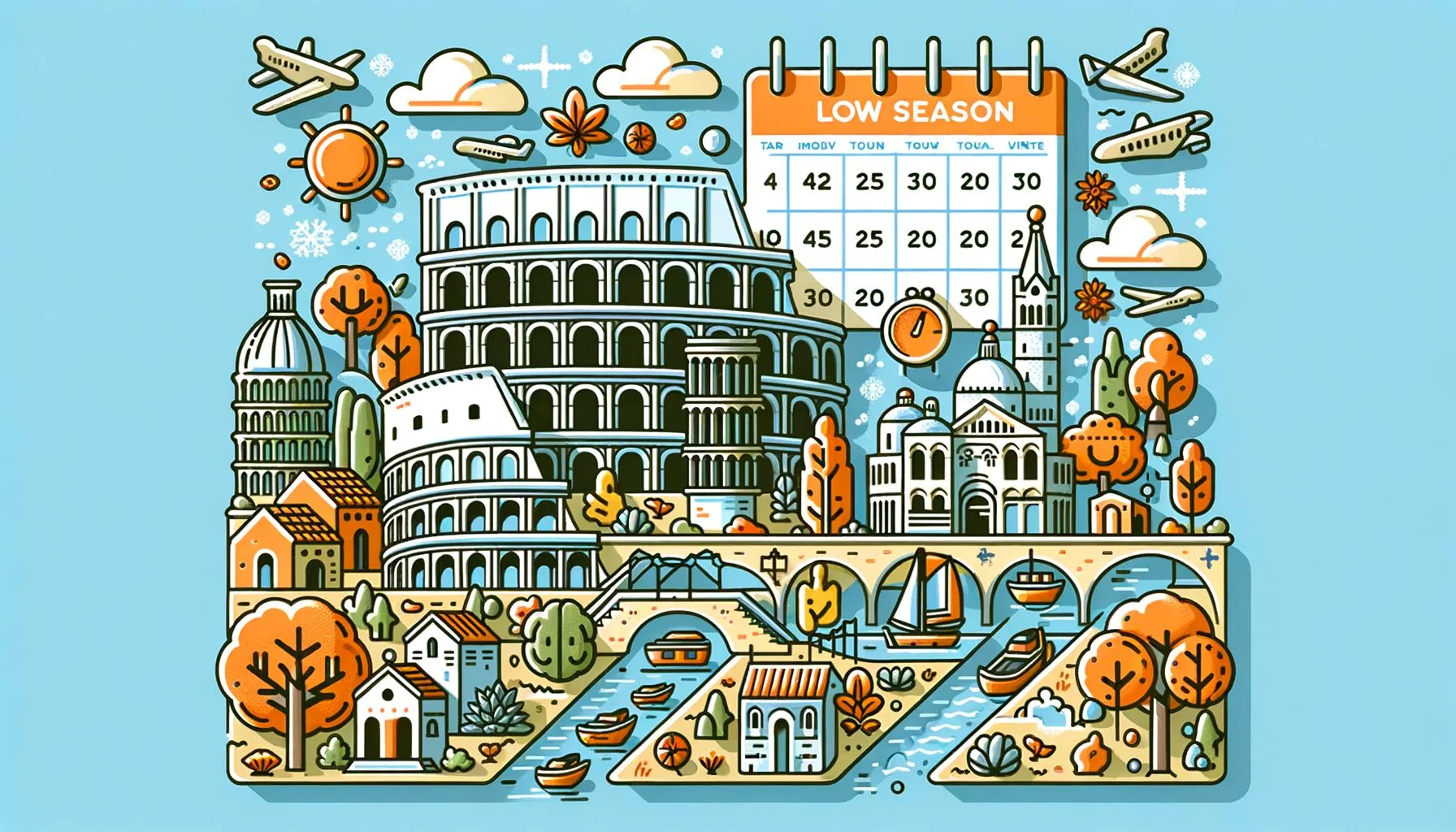When is low season to travel to Italy? Traveling during low season can offer a plethora of benefits, from fewer crowds to lower prices. In this article, we will explore the advantages of visiting Italy during the off-peak periods and provide insights into making the most of a low season trip. From the weather and climate to accommodation availability, we will cover everything you need to know about planning a visit to Italy during its low season.
Traveling during the low season in Italy means experiencing less crowded tourist attractions, which allows for a more intimate and authentic experience. Additionally, accommodations are often more affordable and easier to come by during this time, making it an appealing option for budget-conscious travelers. With this article, readers will gain valuable information on how to plan their visit to Italy during its low season for a truly unforgettable experience.
Weather and Climate
When travelers are considering when is low season to travel to Italy, one important factor to take into account is the weather and climate during this time. Low season in Italy typically falls during the winter months from November to February, with some variations depending on the specific region. During this period, Italy experiences cooler temperatures and occasional rain, with the possibility of snow in certain areas such as the Alps.
While the weather may deter some travelers from visiting Italy during low season, there are also advantages to be found. The cooler temperatures make it ideal for exploring historic sites and museums without having to contend with sweltering heat or large crowds. Additionally, the scenery can be quite picturesque during this time, especially in regions like Tuscany where vineyards and rolling hills take on a different character in the winter months.
It’s important for travelers to consider their own preferences and priorities when deciding whether to visit Italy during low season. While it may not be the best time for beach vacations or outdoor activities, it can offer a more peaceful and authentic experience for those interested in cultural exploration and sightseeing. For those who don’t mind bundling up a bit, low season in Italy can provide a unique opportunity to see popular destinations in a different light.
Crowds and Tourist Attractions
When is low season to travel to Italy? The low season in Italy typically occurs during the winter months, from November to March. During this time, tourist crowds are significantly reduced, making it an ideal period for exploring popular attractions without the usual crowds and long lines. Visiting iconic sites such as the Colosseum in Rome or the Uffizi Gallery in Florence can be a more enjoyable experience when there are fewer tourists around.
Additionally, traveling during low season allows visitors to fully appreciate the beauty and charm of Italy’s famous landmarks, as they are not overrun with tourists. While some outdoor attractions may be affected by the cooler temperatures and shorter daylight hours, many indoor historical sites and museums remain open year-round, offering a more intimate and immersive experience for travelers.
One of the advantages of visiting Italy during low season is having the opportunity to explore less crowded destinations that are often overlooked during high season. This includes smaller towns and villages with hidden gems waiting to be discovered. By venturing off the beaten path, travelers can gain a deeper understanding of Italian culture and traditions while enjoying a more tranquil setting.
| Advantages | Disadvantages |
|---|---|
| Reduced tourist crowds at popular attractions | Cooler temperatures and shorter daylight hours affect outdoor activities |
| Opportunity to explore lesser-known destinations | Potential reduction in operating hours for some establishments |
Accommodation and Prices
Traveling to Italy during the low season has its perks, especially when it comes to accommodation and prices. During the low season, which typically runs from November to March, travelers can take advantage of reduced hotel rates and fewer crowds. This presents an ideal opportunity for budget-conscious travelers or those looking for a quieter and more intimate experience.
When is low season to travel to Italy:
Below are some key factors regarding accommodation and prices to consider when planning a trip to Italy during the low season:
- Availability of Accommodations: During the low season, there tends to be more availability in terms of accommodations. This means that travelers may have better options for finding their desired type of lodging, whether it’s a cozy bed and breakfast in the countryside or a charming boutique hotel in a historic city center.
- Affordability: In addition to increased availability, the cost of accommodations often decreases during this time. Many hotels offer special deals and discounted rates to attract visitors during the off-peak months. This can result in significant savings for travelers on accommodation expenses.
- Tips for Finding Deals: To make the most of the low season, it’s advisable for travelers to keep an eye out for special promotions and offers from hotels and other lodging establishments. Booking in advance or being flexible with travel dates can also increase the chances of securing affordable accommodations.
Overall, traveling during the low season in Italy provides an opportunity for visitors to enjoy comfortable and reasonably priced accommodations without having to contend with large crowds at popular tourist destinations. Whether it’s a charming villa in Tuscany or a cozy guesthouse on the Amalfi Coast, there are plenty of options available for travelers seeking an authentic Italian experience without breaking the bank.
Festivals and Events
Italy is a country known for its rich cultural heritage and vibrant festivals and events throughout the year. When it comes to low season travel to Italy, many visitors may be surprised to discover that this time actually offers unique opportunities to partake in local festivities and traditions.
Unique Festivals and Events
During the low season, Italy hosts a variety of special events that showcase the country’s diverse traditions and customs. From the Carnevale di Venezia in February to the Alba White Truffle Fair in October, there is always something exciting happening in Italy during the off-peak months. Travelers can immerse themselves in local celebrations such as the Festa della Sensa in Venice or the Sagra del Pesce in Camogli, experiencing authentic Italian culture away from the tourist crowds.
Cultural Experiences
One of the advantages of visiting Italy during low season is the opportunity to engage with local communities and participate in traditional cultural experiences. Whether it’s witnessing historic processions, enjoying regional food fairs, or attending religious festivals, travelers can gain insight into Italian customs and rituals that are deeply rooted in history. This provides a chance for a more authentic and immersive experience compared to visiting during high tourist season.
Plan Ahead for Festivals
While low season travel offers unique access to festivals and events, it’s important for travelers to plan ahead and research specific dates and locations. Some festivals may have varying schedules or may take place on specific days of the week, so proper planning ensures that visitors can fully appreciate these cultural celebrations. Additionally, transportation arrangements should be considered when attending events outside of major cities, as some remote areas may have limited options for getting around.
Transportation and Accessibility
Traveling to Italy during the low season can offer some unique advantages, especially in terms of transportation and accessibility. With fewer crowds and lower demand for travel, getting around and navigating the country becomes much more manageable. Here are some key points to consider:
- Transportation Options: During the low season, there may be reduced frequency of certain transportation services such as ferries or trains to smaller towns. However, major cities and popular tourist destinations still maintain regular schedules for buses, trains, and flights.
- Ease of Travel: Navigating Italy becomes less overwhelming during the low season as there are fewer tourists clogging up popular routes and attractions. This means less time waiting in line for public transportation or at popular landmarks.
- Tips for Getting Around: While public transportation is reliable in Italy, renting a car can provide flexibility to explore off-the-beaten-path destinations with ease. Additionally, booking transportation tickets in advance can help save both time and money when traveling during the low season.
Overall, travelers can take advantage of the quieter streets, easier access to popular attractions, and more affordable transportation options when choosing to visit Italy during its low season. By planning ahead and understanding the potential challenges that may arise due to reduced services in certain areas, visitors can make the most of their travels while enjoying a more peaceful experience throughout the country.
Local Cuisine and Dining
When it comes to experiencing the authentic flavors of Italy, visiting during the low season can offer a unique opportunity to indulge in the country’s culinary delights without the hustle and bustle of peak tourist periods. From rich pasta dishes to savory meats and fresh seafood, Italian cuisine is renowned for its diversity and mouthwatering flavors.
During the low season, visitors have the chance to savor these delectable dishes in a more intimate setting, with less crowded restaurants and a greater focus on personalized service.
Seasonal Dishes and Specialties
One of the perks of traveling to Italy during low season is the opportunity to enjoy seasonal dishes and specialties that may not be as readily available during other times of the year. For example, in autumn, visitors can delight in hearty risottos made with freshly foraged mushrooms or roasted chestnuts that are prominent in many traditional recipes.
Additionally, winter brings forth comforting stews and slow-cooked braises that highlight the use of seasonal produce like root vegetables and citrus fruits.
Dining Opportunities
With fewer tourists vying for reservations at popular restaurants, travelers can take advantage of this time to book tables at renowned eateries with greater ease. Whether it’s a family-owned trattoria serving generations-old recipes or a Michelin-starred establishment pushing boundaries with innovative creations, dining experiences in Italy during low season offer a more laid-back atmosphere while still delivering exceptional cuisine.
In addition, food festivals celebrating local delicacies often take place during this time, providing an immersive experience into regional gastronomy.
Exploring Local Markets
For those seeking a more immersive culinary experience, exploring local markets is a must-do activity during low season travel to Italy. These bustling hubs showcase an array of fresh ingredients such as artisanal cheeses, cured meats, olive oils, and aromatic spices. Engaging with local vendors offers insight into the cultural significance of food in Italy while allowing visitors to sample authentic flavors through tastings and cooking demonstrations.
Overall, experiencing Italy’s local cuisine and dining scene during low season provides an opportunity for unforgettable gastronomic adventures with a focus on authenticity and tradition. Whether it’s savoring seasonal specialties or indulging in market-fresh produce, travelers can immerse themselves in the rich culinary heritage of Italy while enjoying a more relaxed and personalized dining experience.
Recommendations and Tips
Traveling to Italy during the low season can provide a unique and fulfilling experience for visitors. The advantages of fewer crowds, better prices, and a chance to immerse oneself in authentic local culture make it an appealing option for many travelers. When is low season to travel to Italy? Typically, the low season in Italy falls between November and March, with some variations depending on specific regions within the country.
One of the significant benefits of visiting Italy during the low season is the opportunity to explore its famous tourist attractions without the usual crowds. From iconic landmarks like the Colosseum in Rome to the historic streets of Florence, low season offers a more intimate experience at these popular sites. Additionally, accommodations are often more readily available and affordable during this time, allowing visitors to enjoy comfortable stays at budget-friendly prices.
Exploring Italy during the low season also provides an opportunity to delight in seasonal festivals and events that may not be as prevalent during other times of the year. Whether it’s savoring traditional dishes at a winter food festival or participating in festive holiday celebrations, visitors can partake in authentic cultural experiences that add depth and richness to their travels.
From indulging in hearty winter dishes to enjoying regional specialties, dining during low season provides a chance to savor Italy’s culinary delights without battling bustling restaurants or exorbitant prices. Ultimately, traveling to Italy during the low season offers a different perspective on this beloved destination, providing an authentic and immersive experience that is both enriching and rewarding for those who choose to visit during this time.

I’m a passionate traveler, writer, and Italophile. My fascination with Italy’s history, art, and culture has led me on countless adventures across the Italian landscape. Through “I Live Italy,” I share my love for this extraordinary country and aims to inspire others to explore its boundless beauty.




